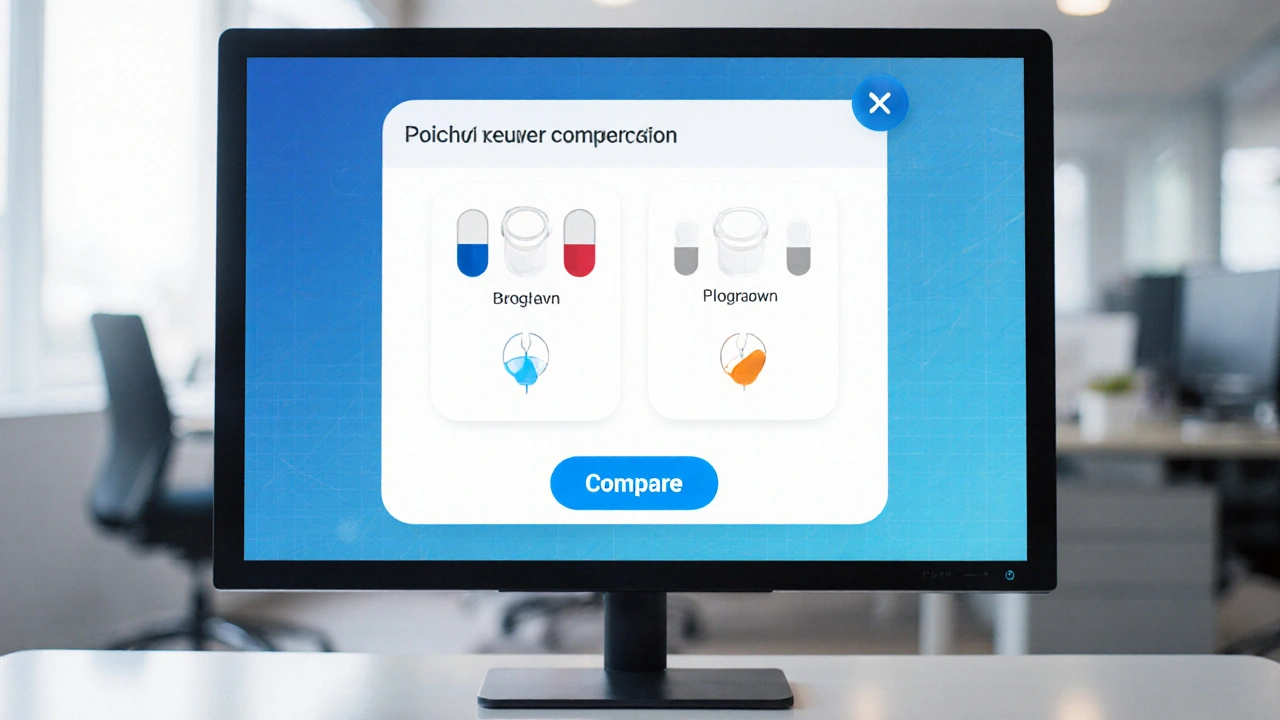Parkinson's Medication Comparison Tool
Compare Parkinson's Medications
Select two medications to compare their key characteristics.
Comparison Results
Select two medications to see their comparison.
Quick Takeaways
- Sinemet combines carbidopa and levodopa to boost dopamine while reducing nausea.
- Stalevo adds entacapone for longer "on" time; Rytary offers extended‑release pellets.
- Duodopa is an intestinal gel used for advanced disease when pills no longer work.
- Non‑levodopa options such as safinamide or rasagiline work by preventing dopamine breakdown.
- Choosing the right drug depends on disease stage, daily schedule, side‑effect tolerance, and cost.
What is Sinemet?
When you see the name Sinemet is a fixed‑dose combination of carbidopa and levodopa, the cornerstone therapy for Parkinson’s disease. The carbidopa component blocks an enzyme that would otherwise turn levodopa into dopamine outside the brain, so more levodopa reaches the central nervous system. This reduces the classic gastrointestinal side effects (nausea, vomiting) that pure levodopa can cause.
How Sinemet Works
Levodopa is a precursor of dopamine. Once it crosses the blood‑brain barrier, brain cells convert it into dopamine, temporarily restoring the lost neurotransmitter. Carbidopa doesn’t cross the barrier, but it stops peripheral conversion, allowing a lower dose of levodopa to be effective. The result is smoother motor control, especially in the early to mid stages of Parkinson’s.
Major Alternatives to Sinemet
While Sinemet works well for many, clinicians often switch or add other agents to manage "wearing‑off" periods, dyskinesias, or specific lifestyle needs. Below are the most common alternatives, each introduced with microdata for easy reference.
Stalevo is a triple combo of carbidopa, levodopa, and entacapone that extends the “on” time by inhibiting the breakdown of levodopa in the periphery. It’s taken three times daily and is popular when a patient experiences early "off" episodes.
Rytary is an extended‑release capsule that delivers levodopa and carbidopa over 4‑6 hours, reducing dosing frequency. Ideal for people who want fewer pills and steadier symptom control.
Duodopa is a continuous intestinal gel (levodopa/carbidopa) delivered via a small jejunal tube, reserved for advanced Parkinson’s when oral meds fail. It provides the most stable plasma levodopa levels.
Apokyn is a subcutaneous infusion of apomorphine, a potent dopamine agonist used for sudden "off" episodes. It works fast but requires careful monitoring for skin reactions.
Safinamide is a reversible MAO‑B inhibitor that also modulates glutamate release, used as an add‑on to levodopa. It improves motor fluctuations without increasing dyskinesia risk.
Rasagiline is an irreversible MAO‑B inhibitor that can be used early or as an adjunct, offering modest symptom control with a low side‑effect profile.
Pramipexole is a non‑ergot dopamine agonist that mimics dopamine activity at D2/D3 receptors, often prescribed for tremor‑dominant disease.
Rotigotine Patch is a transdermal delivery system for a dopamine agonist, providing continuous drug release over 24hours. Useful for patients who have swallowing difficulties.

Key Comparison Criteria
- Formulation type - tablet, capsule, gel, patch, or infusion.
- On‑set and duration - how quickly symptoms improve and how long they last.
- Dosing frequency - number of daily administrations.
- Common side effects - nausea, dyskinesia, orthostatic hypotension, etc.
- Cost & insurance coverage - out‑of‑pocket expense in Australia and overseas.
- Special considerations - need for a feeding tube, skin reactions, or strict timing.
Side‑by‑Side Comparison Table
| Medication | Formulation | Typical Dose | Dosing Frequency | Key Side Effects | Notable Advantage |
|---|---|---|---|---|---|
| Sinemet | Immediate‑release tablet | 25/100mg (carbidopa/levodopa) | 3‑4×/day | Nausea, dizziness, dyskinesia | Well‑studied, widely covered by PBS |
| Stalevo | Immediate‑release tablet | 25/100/200mg (carbidopa/levodopa/entacapone) | 3×/day | Diarrhoea, urine discoloration | Longer "on" time, lower levodopa dose |
| Rytary | Extended‑release capsule | 35/140mg | 2‑3×/day | Sudden onset dyskinesia, constipation | Fewer pills, smoother plasma curve |
| Duodopa | Jejunal gel infusion | 10ml (containing 100mg levodopa/25mg carbidopa) | Continuous | Tube infection, abdominal pain | Most stable levodopa levels, good for "off" |
| Apokyn (apomorphine) | Subcutaneous infusion | 10‑30mg/day | Continuous or rescue bolus | Skin nodules, nausea, hallucinations | Fast rescue for sudden "off" |
| Safinamide | Oral tablet | 50‑100mg | Once daily | Insomnia, hypertension | Improves motor fluctuations without extra dyskinesia |
| Rasagiline | Oral tablet | 1mg | Once daily | Headache, joint pain | Low risk of orthostatic hypotension |
| Pramipexole | Oral tablet/extended‑release | 0.125‑1.5mg | 2‑3×/day | Somnolence, impulse control disorders | Effective for tremor and early disease |
| Rotigotine Patch | Transdermal patch | 2‑8mg/24h | Once daily | Skin irritation, dizziness | No swallowing needed, continuous delivery |
Choosing the Right Option for You
1. Assess disease stage. Early patients often stay on Sinemet or switch to a once‑daily MAO‑B inhibitor like rasagiline to delay levodopa use. Mid‑stage patients who feel "off" before the next dose may benefit from Stalevo or Rytary.
2. Look at daily routine. If you struggle with multiple daily doses, an extended‑release capsule (Rytary) or a patch (Rotigotine) smooths the schedule.
3. Consider side‑effect profile. Nausea‑prone folks prefer the carbidopa component (Sinemet, Stalevo). Those who develop dyskinesia at low levodopa doses might stay on a dopamine agonist (Pramipexole, Rotigotine) longer.
4. Check cost and PBS listing. In Australia, Sinemet, Stalevo, and Rytary are PBS‑approved for most indications. Duodopa and Apokyn require additional specialist approval and are higher‑cost options.
5. Plan for the future. If oral meds become unreliable, discuss advanced therapies (Duodopa, apomorphine pump, or deep brain stimulation) with your neurologist early.
Common Pitfalls & Tips
- Don't “cheat” on timing. Levopoda’s effect drops sharply after 4‑6hours; missing a dose can cause sudden rigidity.
- Watch for “on‑off” swings. If you notice symptoms returning before the next dose, ask about adding entacapone or switching to Rytary.
- Monitor blood pressure. Carbidopa/levodopa can cause orthostatic drops, especially when standing up quickly.
- Stay hydrated. Dehydration worsens nausea and dizziness from levodopa.
- Report impulse‑control behaviours. Dopamine agonists (Pramipexole, Rotigotine) can trigger gambling or compulsive shopping; discuss any changes immediately.
Frequently Asked Questions
Is Sinemet the only levodopa option?
No. Besides Sinemet there are Stalevo (adds entacapone), Rytary (extended‑release), and Duodopa (intestinal gel). Each tweaks the delivery to reduce "off" periods or simplify dosing.
When should I consider switching from Sinemet?
If you notice motor symptoms returning before the next dose, experience frequent nausea despite carbidopa, or need fewer daily pills, talk to your neurologist about Stalevo, Rytary, or a dopamine agonist.
Are there non‑levodopa drugs that work as well?
MAO‑B inhibitors like safinamide and rasagiline can be added to low‑dose levodopa or used alone in early disease. They have milder side effects but usually provide less robust symptom control than levodopa combos.
What are the biggest side effects of the alternatives?
Stalevo may cause diarrhoea; Rytary can lead to sudden dyskinesia; Duodopa requires a feeding tube and can cause infections; dopamine agonists (Pramipexole, Rotigotine) may trigger impulse‑control issues or excessive sleepiness.
How does cost differ across these meds in Australia?
Sinemet, Stalevo and Rytary are listed on the PBS, making them affordable for most patients. Duodopa, Apokyn, and some extended‑release dopamine agonists are specialist‑prescribed and tend to be more expensive, often requiring private health coverage or out‑of‑pocket payment.






Leah Robinson
October 5, 2025 AT 03:21Hey everyone! 🌟 If you’re weighing Sinemet against the other options, remember every brain chemistry is unique, so what works for one might need tweaking for another. The table you shared is gold for spotting dosing frequency and side‑effects at a glance. If you’re new to levodopa combos, start low and titrate slowly – it can make a huge difference in nausea control. And don’t forget to chat with your neurologist about PBS coverage; most of these meds are listed, which eases the wallet stress. Keep sharing your experiences, the community learns together! 😊
Abhimanyu Lala
October 5, 2025 AT 11:41Yo this med battle feels like a drama series u cant miss lol everyone picks side and boom chaos
Richard Sucgang
October 5, 2025 AT 20:01While the comparative chart is aesthetically arranged, one must lament the paucity of citation for adverse‑event frequencies. Moreover, the omission of confidence intervals renders the data rather speculative. In scholarly discourse, such oversights would be deemed unacceptable, hence a call for more rigorous source attribution.
Russell Martin
October 6, 2025 AT 04:21Quick tip: if “off” periods bite before your next Sinemet dose, consider adding entacapone via Stalevo – it prolongs the on‑time without upping levodopa load. Also, syncing medication times with meals can blunt nausea. For tremor‑dominant patients, a low‑dose pramipexole adjunct often smooths residual shaking. Always discuss dosage tweaks with your neurologist to avoid dyskinesia.
Jenn Zee
October 6, 2025 AT 12:41The ethical implications of prescribing high‑cost therapies such as Duodopa without thorough socioeconomic assessment are profoundly troubling. It is incumbent upon clinicians to weigh the fiscal burden placed upon patients against the marginal clinical benefit. When a cheaper alternative like Stalevo offers comparable on‑time extension, the justification for an invasive gel infusion becomes dubious. Moreover, the tacit acceptance of pharmaceutical lobbying in shaping PBS listings undermines the principle of equitable access. The narrative that “more advanced is always better” is a reductive myth perpetuated by market forces. Patients are frequently seduced by the allure of cutting‑edge technology, overlooking the long‑term maintenance challenges. The necessity of a jejunal tube for Duodopa introduces a cascade of potential complications, including infection, dislodgement, and psychological distress. In contrast, the modest but reliable profile of Sinemet, when titrated appropriately, sustains functional independence for many. A comprehensive, patient‑centered approach demands transparent discussion of side‑effect spectra across all options. The omission of thorough counseling about impulse‑control disorders associated with dopamine agonists is a glaring oversight. Equally, the failure to address the risk of orthostatic hypotension in MAO‑B inhibitors betrays a paternalistic attitude. It is also disconcerting that cost considerations are often relegated to a footnote rather than integrated into therapeutic decision‑making. Ethical stewardship requires that providers present a balanced view, highlighting both efficacy and economic impact. The current discourse, however, frequently glorifies novelty at the expense of pragmatism. Ultimately, the goal should be to empower patients with knowledge, not to coerce them toward premium interventions for marginal gains. In sum, a judicious, evidence‑based selection grounded in patient values remains the gold standard.
don hammond
October 6, 2025 AT 21:01Ah, the age‑old “pick the flashiest pill” debate, how original 🤦♂️. I’m sure the doctors love that you’ve read the whole pamphlet, right? 🙃 Remember, a patch that sticks to your skin isn’t a fashion statement. 😏
Ben Rudolph
October 7, 2025 AT 05:21Nice try.
Judson Voss
October 7, 2025 AT 13:41The data presented is comprehensive, yet it lacks patient‑reported outcomes which are crucial for real‑world applicability. Including quality‑of‑life metrics would enhance the comparative analysis. Future updates should integrate those perspectives.
Jessica Di Giannantonio
October 7, 2025 AT 22:01Wow, this breakdown really lights up the path for anyone navigating the medication maze! 🌈 It feels like a breath of fresh air when complex info is laid out so clearly. Keep the good vibes coming, and remember we’re all in this together. Your effort makes a huge difference! ✨
RUCHIKA SHAH
October 8, 2025 AT 06:21Choosing a med is like picking a tool for a job it must fit the need. Look at side effects and daily routine. Talk to your doctor and ask about cost. Simple steps help avoid big problems later. Stay calm and stay informed